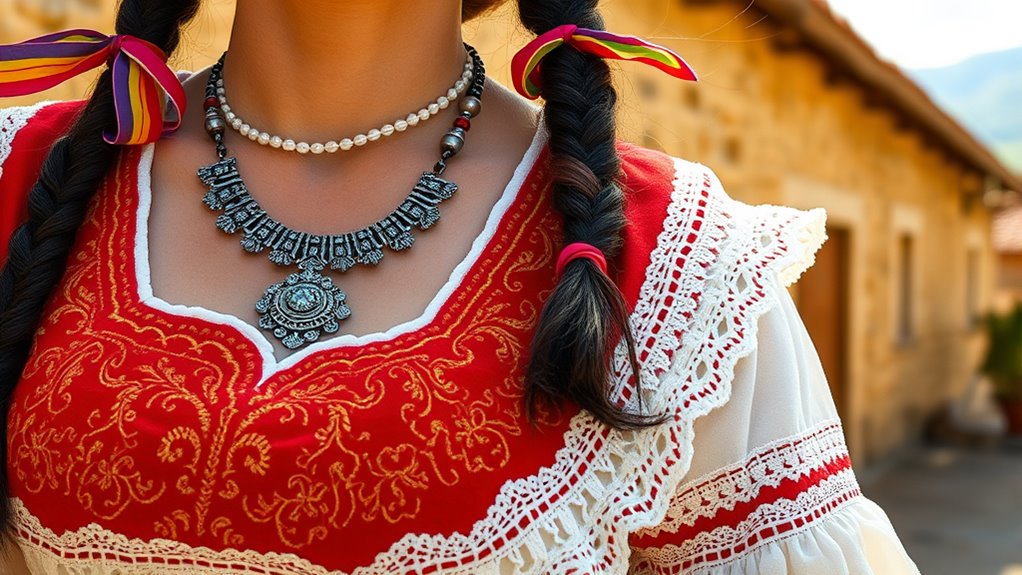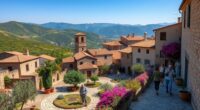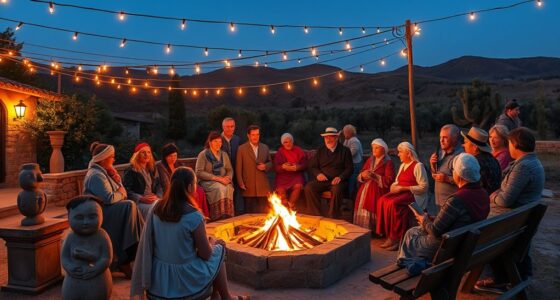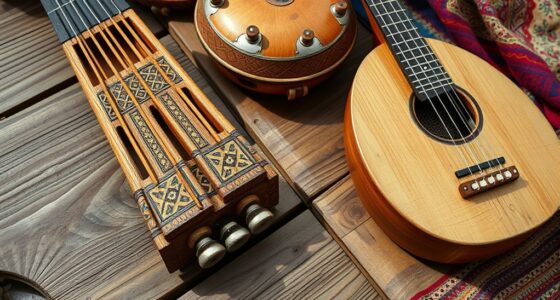Sardinian folk costumes showcase the island’s rich regional diversity, with over 400 distinct styles reflecting local traditions, history, and social identity. You’ll notice vibrant colors, embroidery, and influences from Spanish and Moorish cultures, with each town having unique features. These costumes serve as symbols of pride, community, and land, especially during festivals and rituals. To uncover more about their intricate beauty, history, and significance, there’s much more to explore.
Key Takeaways
- Sardinian folk costumes feature over 400 regional variants, each representing specific towns, social groups, and cultural identities.
- They incorporate vibrant colors, embroidery, and motifs influenced by Moorish and Spanish traditions, reflecting regional history.
- Materials mainly include wool, linen, and cotton, with silk accents for ceremonial attire, crafted through traditional weaving and embroidery techniques.
- Costumes are vital during festivals and rituals, symbolizing community pride, land, and social status, often with symbolic accessories and motifs.
- Preservation efforts include visual documentation, museums, digital archives, and community festivals that promote cultural continuity and craftsmanship.
The Rich Diversity of Regional Styles

Have you ever wondered how Sardinian folk costumes reflect the island’s cultural richness? Sardinia boasts over 400 distinct traditional costumes, each representing a specific town, village, or social status. Every location has its own unique style, making the island’s costume diversity greater than that of the entire Italian mainland. For example, towns like Ploaghe, Bonnanaro, Osilo, and Oliena each feature distinct motifs, colors, and accessories. Coastal towns like Cabras have men wearing red kilts and performing barefoot, highlighting regional variations. These costumes incorporate vibrant colors, intricate embroidery, and influences from Spanish and Moorish traditions. The variety emphasizes local identity and social distinctions, showcasing Sardinia’s rich cultural tapestry through its remarkable regional dress styles. More than 400 distinct costumes reflect the diversity and history of Sardinian communities, emphasizing their importance in cultural heritage.
Cultural Significance and Historical Roots
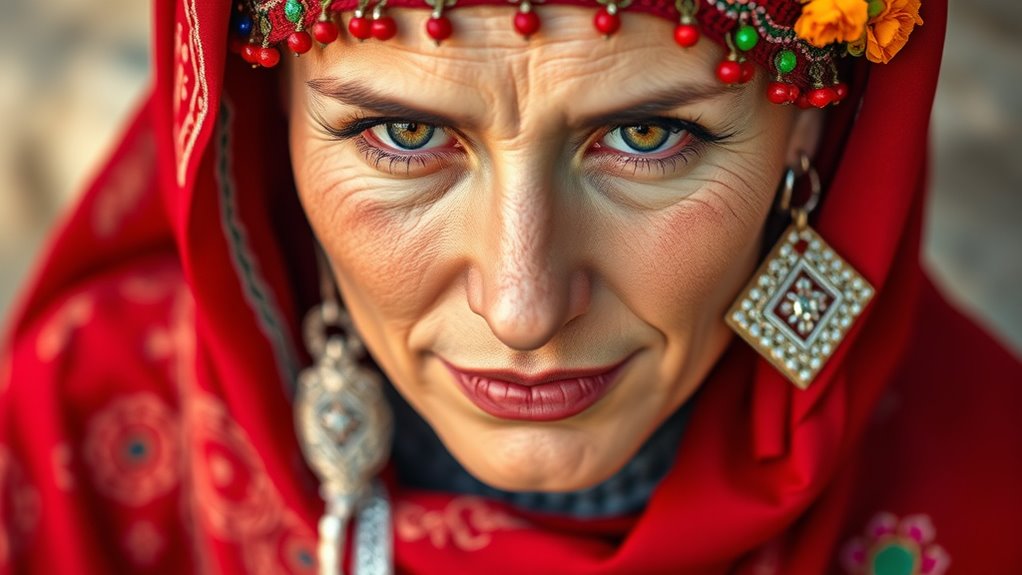
The cultural significance and historical roots of Sardinian folk costumes run deep, reflecting centuries of tradition, social structure, and regional identity. These garments have evolved from ancient weaving practices dating back to the Bronze Age, with their designs often indicating social status, region, or marital status. Travelers in the 18th and 19th centuries documented their magnificence, capturing their essence in lithographs and watercolors. They serve as symbols of community, land, and pride, worn during festivals and rituals to preserve cultural memory. The intricate craftsmanship involved in creating these costumes demonstrates a mastery of traditional techniques passed down through generations. The regional motifs found on the costumes often carry symbolic meanings specific to each area, further emphasizing local identity. Here’s a snapshot of their importance:
| Aspect | Description | Example |
|---|---|---|
| Origins | Bronze Age weaving traditions | Wool, linen, cotton |
| Social Role | Indicate status and identity | Regional motifs |
| Ceremonial Use | Worn during festivals and rites | Carnival costumes |
| Craftsmanship | Handwoven, embroidered with precious threads | Gold and silver embroidery |
| Cultural Meaning | Embody community, land, and history | Symbolic motifs |
Key Elements of Traditional Attire
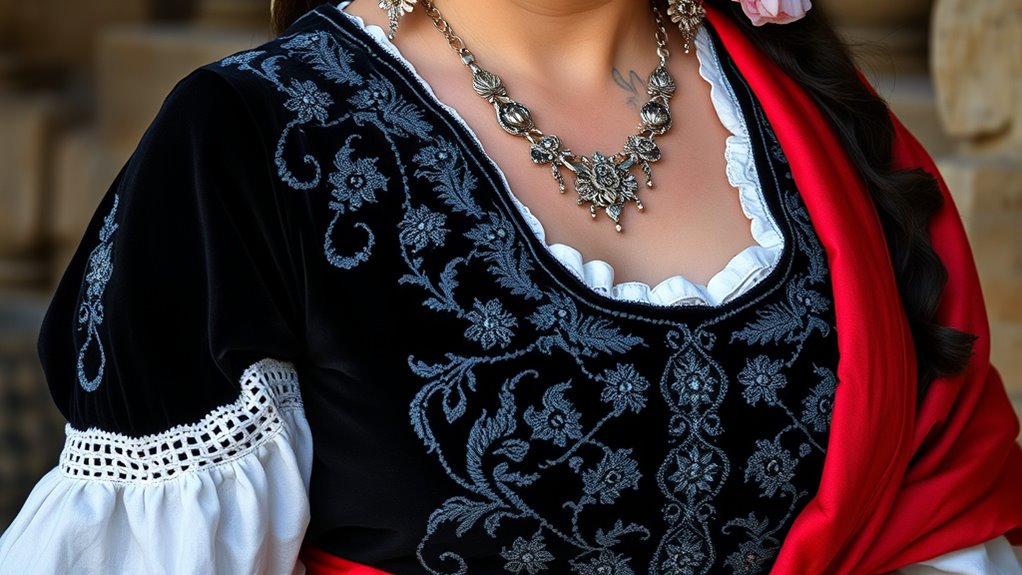
Traditional Sardinian attire is defined by distinct elements that showcase regional identities and social status. Women typically cover their heads with caps, handkerchiefs, shawls, or capes, sometimes lifting a skirt on their head. Men wear soft, cylindrical wool caps about half a meter long, which can be worn in various styles. These accessories signal social, marital, or regional distinctions. Foundational garments include linen or cotton chemises for women and woolen foustanellas for men, layered for warmth and modesty. Women’s outerwear features colorful embroidered gowns, corsets, and richly decorated aprons, often with regional motifs. Accessories like embroidered bands, silk ribbons, shawls, and caps further emphasize cultural identity and social standing. These elements collectively reflect Sardinia’s vibrant heritage and community bonds. Additionally, traditional attire often incorporates specific regional motifs and embroidery techniques that further distinguish different areas of Sardinia.
Materials and Craftsmanship Techniques

Sardinian folk costumes are crafted from a variety of materials that highlight the island’s resourcefulness and craftsmanship. Sheep’s wool is the primary raw material, valued for its durability and insulation, with regional orbace fabric used extensively in garments. Plant fibers like flax, hemp, and cotton add variety but are less common. Imported silks enhance ceremonial attire, adding luxury and vibrant color. Leather and linen also feature in accessories and costume details. Traditional weaving is a key craft, passed down through generations, often involving pleating and layering to create distinctive skirts and shawls. Embroidery plays a crucial role, showcasing intricate floral and geometric patterns that symbolize local identity. These techniques, combined with natural dyeing, produce richly textured garments reflecting Sardinia’s cultural heritage. Embroidery remains a vital craft that continues to be practiced and celebrated by artisans today. Additionally, the local materials are often dyed using traditional methods, which contribute to the garments’ unique appearance.
Visual Documentation Through History
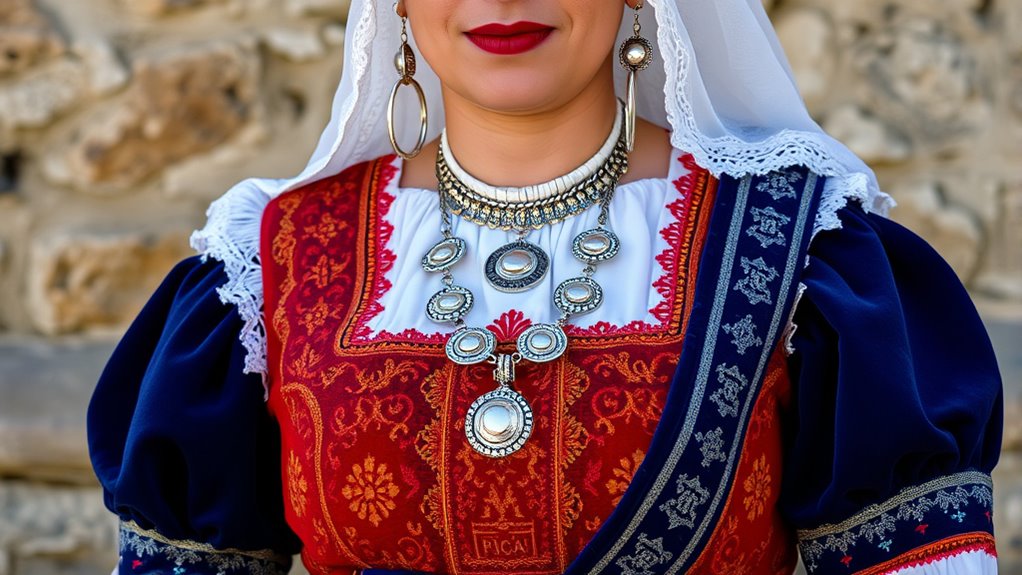
You can explore Sardinian folk costumes through iconographic sources like paintings and sketches by artists who captured regional details. Historical illustrations and lithographs reveal how costumes evolved and helped preserve their cultural significance. Museums and exhibits now showcase these visual records, allowing you to appreciate their historical and artistic value. These visual sources serve as invaluable tools for understanding the intricate details and regional variations of traditional Sardinian dress over centuries. Additionally, cultural preservation efforts have emphasized the importance of documenting these costumes to maintain regional identity.
Iconographic Sources and Artists
Throughout history, artists and photographers have played a pivotal role in documenting Sardinian folk costumes, capturing their intricate designs and regional variations. Their work offers valuable visual records, from early 20th-century photographs to contemporary images. You can observe:
- Photographers documenting festivals like Cavalcata Sarda, which showcase regional costumes’ colors and details.
- Visual artists collaborating with communities to preserve authentic identities, often linking costumes to rituals and beliefs.
- Online archives and personal blogs compiling collections that serve as modern iconographic resources for cultural and academic research.
- The preservation of these visual records helps safeguard the rich diversity of Sardinian attire, highlighting differences across communities and social functions, enriching our understanding of local traditions and cultural heritage.
Historical Illustrations and Lithographs
Historical illustrations and lithographs have played a crucial role in documenting Sardinian folk costumes, offering visual snapshots of regional dress patterns before the advent of photography. Early illustrations, created by travelers and ethnographers, provide valuable insights into traditional attire and cultural practices. In the 19th century, lithographic prints delivered detailed depictions, highlighting regional diversity across Sardinia’s areas. As photography emerged, it allowed for more comprehensive documentation, capturing intricate costume details and variations more accurately. These images were published in books and journals, spreading awareness of Sardinian traditions. Ethnographic studies further emphasized the cultural significance of costumes, revealing their role in identity, social status, and regional pride. Additionally, research into visual documentation techniques has helped preserve these images for future generations. Together, these visual sources form a vital record of Sardinian costume history through the ages.
Visual Preservation and Exhibits
Visual preservation of Sardinian folk costumes has advanced through diverse exhibits and collections that showcase the island’s rich cultural heritage. These displays capture the evolution and diversity of traditional clothing, allowing you to explore Sardinia’s unique regional styles. Regional collections preserve costumes tied to specific towns, highlighting local craftsmanship. Additionally, many museums host interactive exhibits that provide detailed explanations of the garments’ historical and cultural contexts. Museum exhibits often feature costumes during festivals, emphasizing cultural significance. Digital platforms offer virtual access, enabling broader audiences to engage with Sardinian heritage. These initiatives not only preserve the visual history but also incorporate modern digital preservation methods that enhance accessibility and engagement. Through these methods, you can see how historical accounts, photographs, and modern digital efforts combine to document and celebrate Sardinian costumes. These initiatives not only preserve the visual history but also foster community pride and educational opportunities, ensuring these traditions endure for future generations.
Modern Preservation and Usage
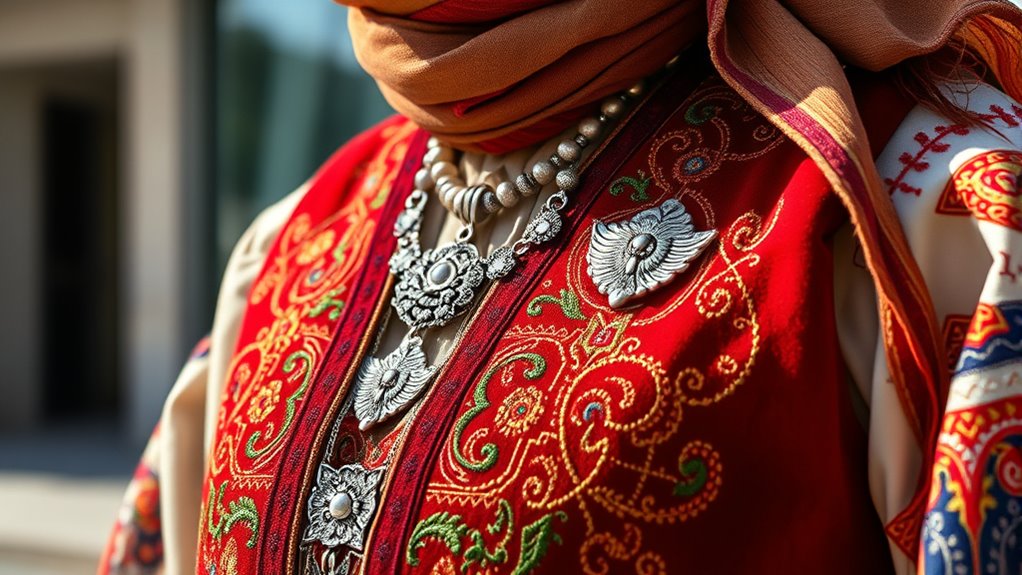
You can help maintain Sardinian folk costumes by participating in festivals and cultural events that showcase traditional attire. Visiting museums and viewing artifacts keeps the history alive and educates others about their significance. Supporting contemporary initiatives also ensures that these costumes remain a vibrant part of Sardinian culture for future generations. Active engagement with local communities is essential to preserve the detailed craftsmanship and unique styles of Sardinian costumes. Additionally, understanding the cultural significance behind each element can foster greater appreciation and encourage respectful preservation efforts.
Festivals and Cultural Events
How do Sardinian festivals today keep traditional folk costumes alive and relevant? They showcase costumes in vibrant parades, performances, and markets, ensuring visibility and appreciation. Here’s how they do it:
- They organize large-scale events like the Cavalcata Sarda, which features over 200 participants dressed in traditional attire, celebrating local culture through music, dance, and craft stalls.
- Festivals like Mamoiada Carnival highlight masked figures such as Mamuthones and Issohadores, maintaining costume traditions through theatrical and ritual displays.
- Smaller village festivals throughout Sardinia actively involve community members in wearing costumes during seasonal celebrations, reinforcing local identity and passing traditions to new generations.
- These festivals also incorporate educational programs and workshops, helping younger generations learn the significance and craftsmanship behind the costumes, ensuring their preservation for the future.
These events keep folk costumes dynamic, relevant, and central to Sardinian cultural life today.
Museums and Artifacts
Museums dedicated to Sardinian folk costumes play a crucial role in preserving and showcasing traditional attire for future generations. The Museo del Costume in Nuoro, opened in 1976, is Sardinia’s largest ethnographic museum, displaying over 5,000 artifacts including costumes, jewelry, masks, textiles, and tools. Its architectural design reflects various Sardinian styles, creating an immersive experience. Costumes from the late 19th and early 20th centuries, representing different regions, are rotated regularly to protect their integrity. Mannequins display authentic garments, offering lifelike views of traditional dress. Exhibits also include jewelry, amulets, and household tools that depict daily life. The museum’s collaboration with research institutes ensures ongoing documentation, conservation, and updates, making it a vital resource for understanding Sardinian cultural heritage. It houses approximately 80 authentic traditional clothes from different parts of Sardinia, providing a comprehensive overview of regional variations in folk attire. Additionally, efforts to document and conserve these artifacts help keep Sardinian traditions alive for future generations.
Contemporary Cultural Initiatives
Contemporary cultural initiatives play a crucial role in preserving Sardinian folk costumes by leveraging innovative approaches and community involvement. These efforts include digitalizing costumes through projects like the Bistìris ontology, which documents and structures knowledge about traditional attire. Community engagement is essential; local institutions collaborate with artisans in workshops and educational programs to sustain craftsmanship. Additionally, these initiatives boost the local economy by supporting artisans and creating market platforms for their work. To summarize:
- Digital archives and innovative documentation methods.
- Educational programs and workshops for artisans and youth.
- Market platforms and economic support to sustain craftsmanship. Many of these initiatives utilize modern technology to reach wider audiences and ensure the longevity of Sardinian cultural heritage. These strategies help preserve Sardinian cultural identity, promote cultural exchange, and guarantee that traditional costumes remain relevant and celebrated today.
Symbolic Meanings and Social Identity
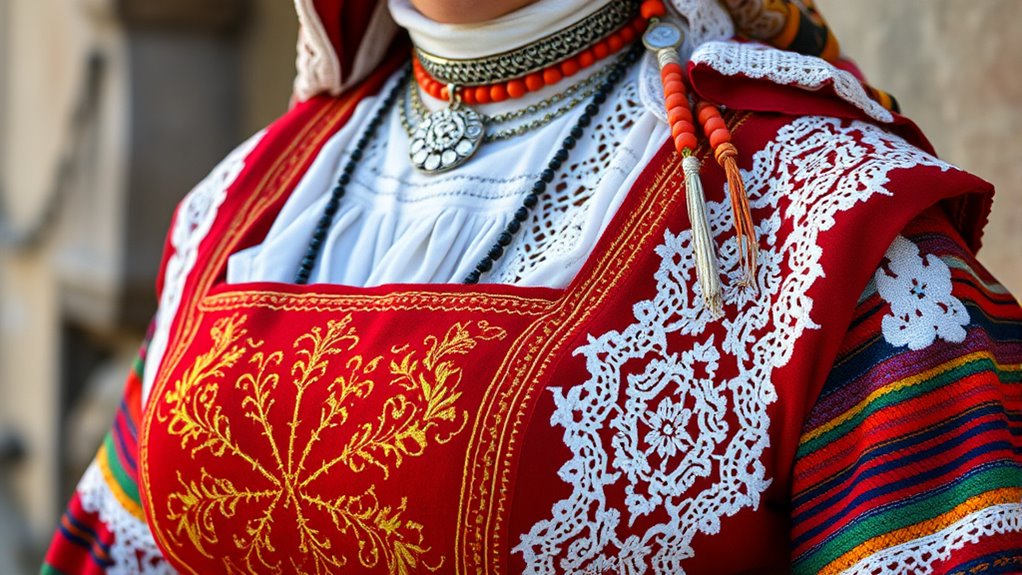
In Sardinian folk costumes, symbolic elements serve as powerful markers of social identity and cultural origin. You’ll notice amulets like Su Coccu, the “eye of Saint Lucia,” offering protection against negative energies and evil influences. Sardinian buttons not only decorate but also symbolize cultural pride and safeguard the wearer. Over 400 costume variants reflect specific towns, villages, and social groups, with fabric, color, and decoration indicating origin and status. Traditional materials like wool, leather, and silk reveal social distinctions, while embroidery and jewelry signal wealth and craftsmanship. Costumes also play roles in rituals and ceremonies, marking life stages and community roles. These symbols and distinctions preserve Sardinian identity, linking the present to ancestral beliefs and collective memory. They serve as tangible expressions of Sardinian craftsmanship and heritage, reinforcing community bonds and cultural continuity.
The Role of Festivals and Cultural Events
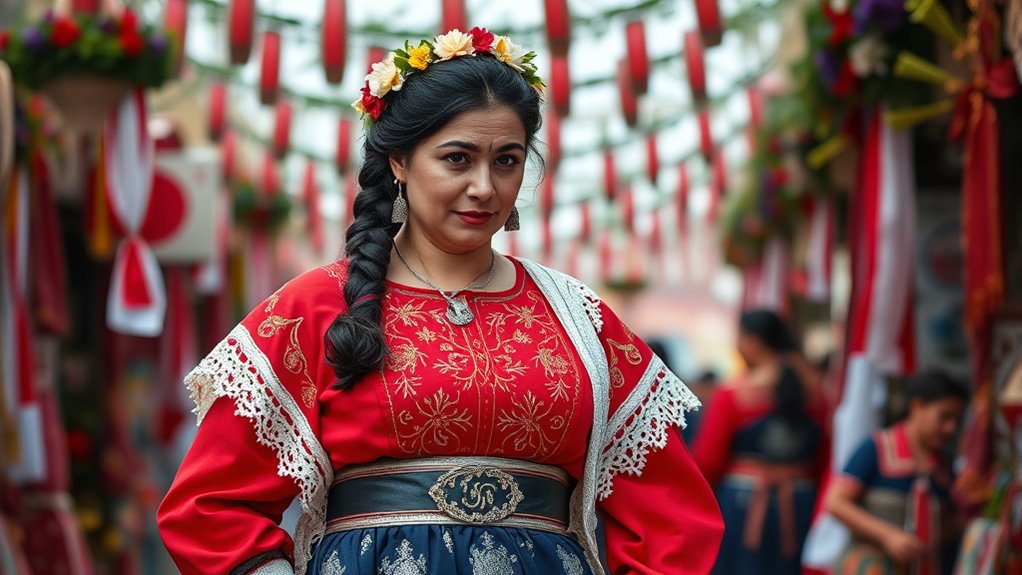
Festivals and cultural events play an essential role in preserving and showcasing Sardinian folk costumes by turning them into living expressions of tradition. These gatherings act as living museums, highlighting regional differences through parade displays. For example, you might notice:
- The Cavalcata Sarda, with 2,000 participants from 60 towns, features lively music, dance, and traditional attire.
- Sa Sartiglia in Oristano showcases masked performers in medieval costumes, symbolizing historical continuity.
- The Sant’Efisio procession in Cagliari involves thousands dressed in historical costumes, reinforcing religious and social bonds.
These events encourage intergenerational skills transmission, promote local pride, and serve as media opportunities to raise awareness of textile heritage. They also attract tourists, supporting local economies and ensuring the survival of Sardinian costume traditions.
Frequently Asked Questions
How Have Sardinian Costumes Evolved Over the Last Century?
Over the last century, you’ve seen Sardinian costumes shift from everyday clothing to mainly festive and ceremonial wear. While once common in daily life, today they symbolize regional identity and cultural pride. You notice variations across villages, with intricate fabrics and embroidery reflecting local traditions. Despite reduced everyday use, communities preserve these costumes through festivals, weddings, and cultural events, keeping alive a rich artisanal heritage that highlights Sardinia’s unique history and craftsmanship.
What Influences Have Shaped Regional Differences in Sardinian Dress?
You see that regional differences in Sardinian dress are shaped by a mix of historical, geographic, and social influences. Spanish and Moorish rule introduced distinct styles, while local craft traditions preserved unique embroidery and weaving techniques. Geographically, coastal and inland villages use different materials, and mountain areas favor heavier fabrics. These factors, combined with social status and local pride, keep each community’s costume distinctive, reflecting its unique heritage and environment.
Are There Specific Rituals Associated With Wearing Traditional Sardinian Costumes?
You’ll notice that wearing traditional Sardinian costumes is often linked to powerful rituals. During weddings, you dress in elaborate garments for ceremonies, processions, and celebrations that honor ancient customs. In festivals like Carnival, costumes symbolize farming rites and community bonds, transforming participants into mythic figures. These rituals reinforce cultural identity, foster community spirit, and connect you to Sardinia’s rich history through symbolic dress and collective participation.
How Do Artisans Today Preserve Traditional Costume-Making Techniques?
Think of traditional costume-making as a precious tapestry that you help weave. Today, artisans preserve these techniques by using local, natural materials and passing skills through apprenticeships, much like nurturing a fragile seed. They blend old methods with modern designs, keeping the craft alive and relevant. By sharing their work on digital platforms, they guarantee that Sardinian craftsmanship continues to flourish, connecting past and present in every stitch.
Can Visitors Participate in Wearing Sardinian Costumes During Festivals?
You might wonder if you can wear Sardinian costumes during festivals. Generally, visitors don’t participate in costume wearing out of respect for local traditions. Most festivals keep costumes reserved for locals, especially during sacred or ceremonial moments. However, you can explore cultural centers, museums, or workshops where you might try on replicas or see costumes up close. Always remember to honor the community’s wishes and avoid inappropriate costume use.
Conclusion
You’ve seen how Sardinian folk costumes embody rich history and regional pride. Did you know that over 50 distinct styles exist across the island, each telling its own story? By understanding these traditional garments, you connect with Sardinia’s cultural roots and social identity. As festivals and events keep these costumes alive, you contribute to preserving a vibrant heritage that continues to inspire and unite communities today.
